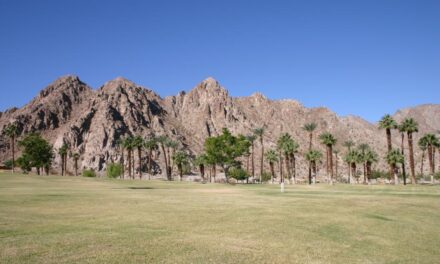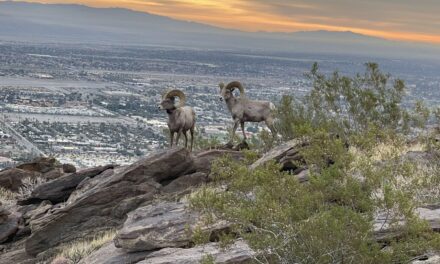Day hikers at California’s Coachella Valley Preserve can encounter a lizard whose camouflage is so good that it has virtually no shadow.
The 1.6-miles round-trip Indian Palms Trail also heads to two small oases. From June through September, the 17,000-acre preserve is open from 6 a.m. to 8 p.m. then in winter from 8 a.m. to 4 p.m. Wednesday through Sunday.
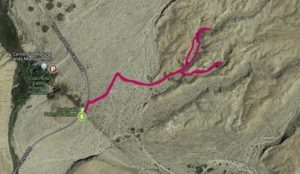
Indian Palms Trail map
To reach the trailhead, take Interstate 10 to Thousand Palms and exit onto East Ramon Road. Go east on it. Next, turn left/north onto Thousand Palms Canyon Road. A parking lot is on the road’s left/southwest side; this serves the McCallum Trailhead with Indio Hills Palms and the Center for Natural Lands Management located there. Take the trail heading southeast toward the Pushawalla Palms Trailhead.
To the trail’s south is Squaw Hill, which rises about 70 feet. Another path heads to its top, which gives a great view of the valley’s western side.
Upon reaching the highway, cross it to the trailhead sign. The stone-sided trail begins by entering a wash. Floods in autumn 2018 covered the wash, but the trail since has been repaired.
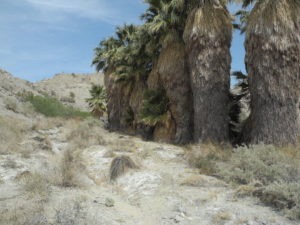
The Indian Palms Trail is a short hike across the desert to two small oases.
While the preserve is more known for the endangered Coachella Valley fringe-toed lizard, plenty of other reptiles live there. Among them is the camouflage master flat-tailed horned lizard.
Found only in southeastern California, southwestern Arizona, Sonora, and Baja California Norte, the lizard has a round, flat body with a dark vertebral stripe and a broad, flat tail. Long spines sit on its head. The lizard’s color changes to match the local sand, so the Coachella Valley’s denizens tend to be whiter than its counterparts. The Coachella Valley marks the northern margin of the species’ range.
The flat-tailed horned lizard mainly eats ants though sometimes it will dine on beetles and other bugs. As standing water is rare in the preserve and other locations that the lizard lives, it acquires most of its water when eating.
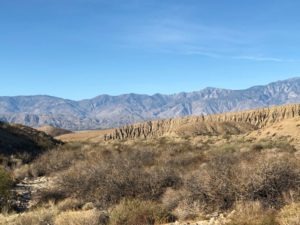
The Indian Palms Trail is a short hike across the desert to two small oases.
In short order, the trail splits. Each way takes you to a desert oases to either the north or south.
Go left to the northern grove. The trail heads up a slight slope and then loops around a small group of California fan palms. Water seeping up through faults in the area helps water the palms.
Among the rocks only a few feet from the oasis are barrel cactus, creosote bushes, and sandpaper plants.
Another plant you’ll pass along the way is four-wing saltbush. Slow down when you do, as these plants mark the best places to spot the flat-tailed horned lizard. As the saltbush produces fruit even during droughts, they naturally attract large ant populations, which in turn draws the flat-tailed horned lizard.
Four-wing saltbush is a type of evergreen shrub. They usually grow 2-4 feet high with thin leaves about 0.5-2 inches long. Their fruit is what really makes them stand out, though. The fruit has four wings at right angles to one another. The wings are densely packed on long stems.
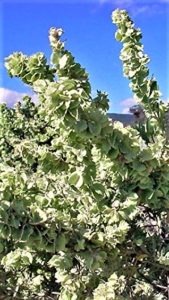
Look for the flat-tailed horned lizard where four-winged saltbush grows alongside the trail.03 Look for the flat-tailed horned lizard where four-winged saltbush grows alongside the trail.
Finding the flat-tailed horned lizard will be tougher than you think. As the sides of their flat bodies thin to an edge and they press their bodies to the ground, there’s no shadow to make them stand out. The fringed scales on their sides further obscure them by helping them blend into the sand.
After looping around the grove, head to back to the junction and then go to the south grove. Though smaller than the northern oases, usually puddles of water can be spotted.
The flat-tailed horned lizard faces a number of threats. Kestrels and shrikes will hunt them, so their populations tend to be low with 0.1 miles of roads, which provide open ground and poles and power lines for the birds to perch. In addition, Russian thistle and Sahara mustard can limit movement of the lizards, which tend to be wide-bodied. Further, populations are becoming fragmented, reducing breeding populations. In the Coachella Valley, Interstate 10, the Coachella Canal, and other small roads effectively divide up the lizards’ habitat.
After taking in the south grove, return to the junction and retrace your steps to the parking lot.
Avoid this trail during summer or anytime temperatures are in the 80s or higher. Always don sunscreen, sunglasses and a sunhat, as there is no shade on the trail. Pets are not allowed in the preserve.
Image Sources
- Indian Palms Trail map: Rob Bignell
- Ttwo small oases: Rob Bignell
- Indian Palms Trail: Rob Bignell
- Saltbush: Rob Bignell
- Flat-tailed horned lizard: Roob Bignell


